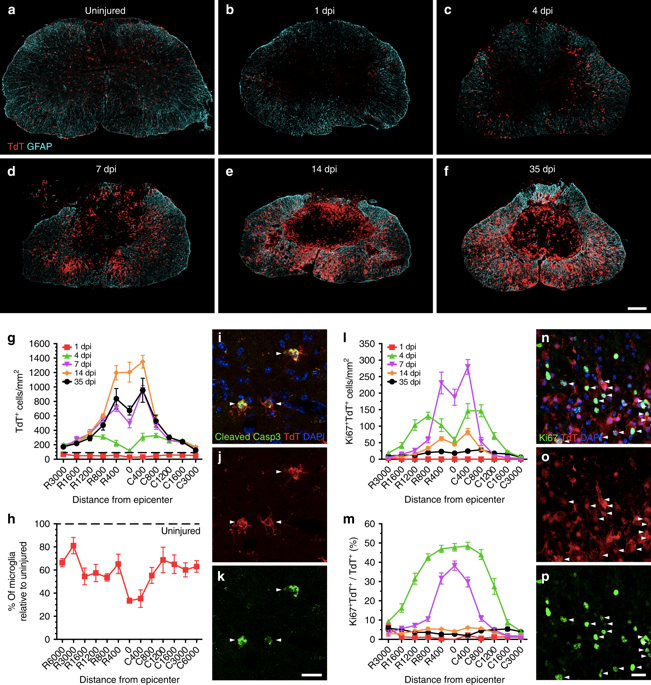当前位置:
X-MOL 学术
›
Nat. Commun.
›
论文详情
Our official English website, www.x-mol.net, welcomes your
feedback! (Note: you will need to create a separate account there.)
Microglia are an essential component of the neuroprotective scar that forms after spinal cord injury.
Nature Communications ( IF 14.7 ) Pub Date : 2019-01-31 , DOI: 10.1038/s41467-019-08446-0 Victor Bellver-Landete 1 , Floriane Bretheau 1 , Benoit Mailhot 1 , Nicolas Vallières 1 , Martine Lessard 1 , Marie-Eve Janelle 2 , Nathalie Vernoux 1 , Marie-Ève Tremblay 1 , Tobias Fuehrmann 3 , Molly S Shoichet 3 , Steve Lacroix 1
Nature Communications ( IF 14.7 ) Pub Date : 2019-01-31 , DOI: 10.1038/s41467-019-08446-0 Victor Bellver-Landete 1 , Floriane Bretheau 1 , Benoit Mailhot 1 , Nicolas Vallières 1 , Martine Lessard 1 , Marie-Eve Janelle 2 , Nathalie Vernoux 1 , Marie-Ève Tremblay 1 , Tobias Fuehrmann 3 , Molly S Shoichet 3 , Steve Lacroix 1
Affiliation

|
The role of microglia in spinal cord injury (SCI) remains poorly understood and is often confused with the response of macrophages. Here, we use specific transgenic mouse lines and depleting agents to understand the response of microglia after SCI. We find that microglia are highly dynamic and proliferate extensively during the first two weeks, accumulating around the lesion. There, activated microglia position themselves at the interface between infiltrating leukocytes and astrocytes, which proliferate and form a scar in response to microglia-derived factors, such as IGF-1. Depletion of microglia after SCI causes disruption of glial scar formation, enhances parenchymal immune infiltrates, reduces neuronal and oligodendrocyte survival, and impairs locomotor recovery. Conversely, increased microglial proliferation, induced by local M-CSF delivery, reduces lesion size and enhances functional recovery. Altogether, our results identify microglia as a key cellular component of the scar that develops after SCI to protect neural tissue.
中文翻译:

小胶质细胞是脊髓损伤后形成的神经保护性瘢痕的重要组成部分。
小胶质细胞在脊髓损伤(SCI)中的作用仍然知之甚少,并且常常与巨噬细胞的反应相混淆。在这里,我们使用特定的转基因小鼠品系和耗竭剂来了解SCI后小胶质细胞的反应。我们发现小胶质细胞是高度动态的,在头两周内大量增殖,在病灶周围积聚。在那里,活化的小胶质细胞将自身定位在浸润的白细胞和星形胶质细胞之间的界面处,这些细胞在对小胶质细胞衍生的因子(例如IGF-1)的反应中增殖并形成疤痕。SCI后小胶质细胞的消耗会破坏神经胶质疤痕的形成,增强实质性免疫浸润,减少神经元和少突胶质细胞的存活,并损害运动恢复。相反,由局部M-CSF递送引起的小胶质细胞增殖增加,减小病变大小并增强功能恢复。总的来说,我们的研究结果确定小胶质细胞是瘢痕形成的关键细胞成分,在SCI后形成,以保护神经组织。
更新日期:2019-01-31
中文翻译:

小胶质细胞是脊髓损伤后形成的神经保护性瘢痕的重要组成部分。
小胶质细胞在脊髓损伤(SCI)中的作用仍然知之甚少,并且常常与巨噬细胞的反应相混淆。在这里,我们使用特定的转基因小鼠品系和耗竭剂来了解SCI后小胶质细胞的反应。我们发现小胶质细胞是高度动态的,在头两周内大量增殖,在病灶周围积聚。在那里,活化的小胶质细胞将自身定位在浸润的白细胞和星形胶质细胞之间的界面处,这些细胞在对小胶质细胞衍生的因子(例如IGF-1)的反应中增殖并形成疤痕。SCI后小胶质细胞的消耗会破坏神经胶质疤痕的形成,增强实质性免疫浸润,减少神经元和少突胶质细胞的存活,并损害运动恢复。相反,由局部M-CSF递送引起的小胶质细胞增殖增加,减小病变大小并增强功能恢复。总的来说,我们的研究结果确定小胶质细胞是瘢痕形成的关键细胞成分,在SCI后形成,以保护神经组织。































 京公网安备 11010802027423号
京公网安备 11010802027423号